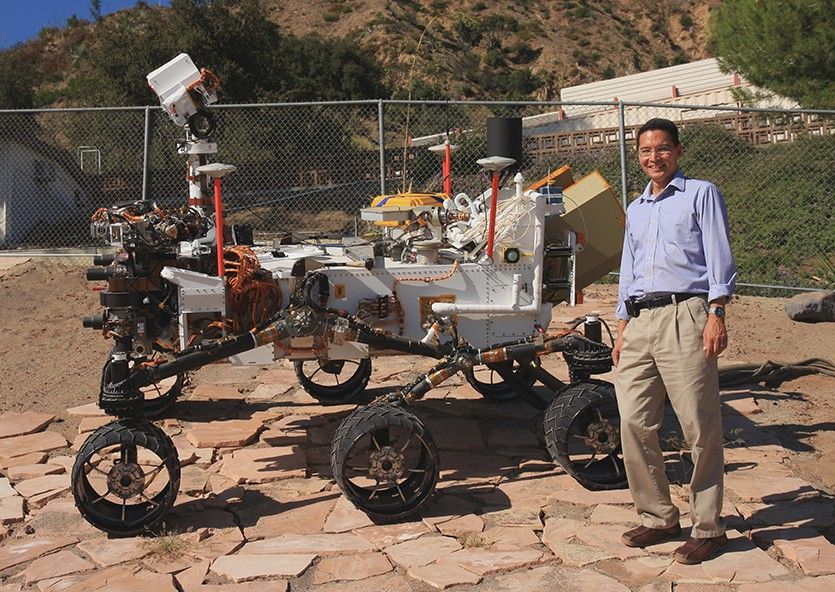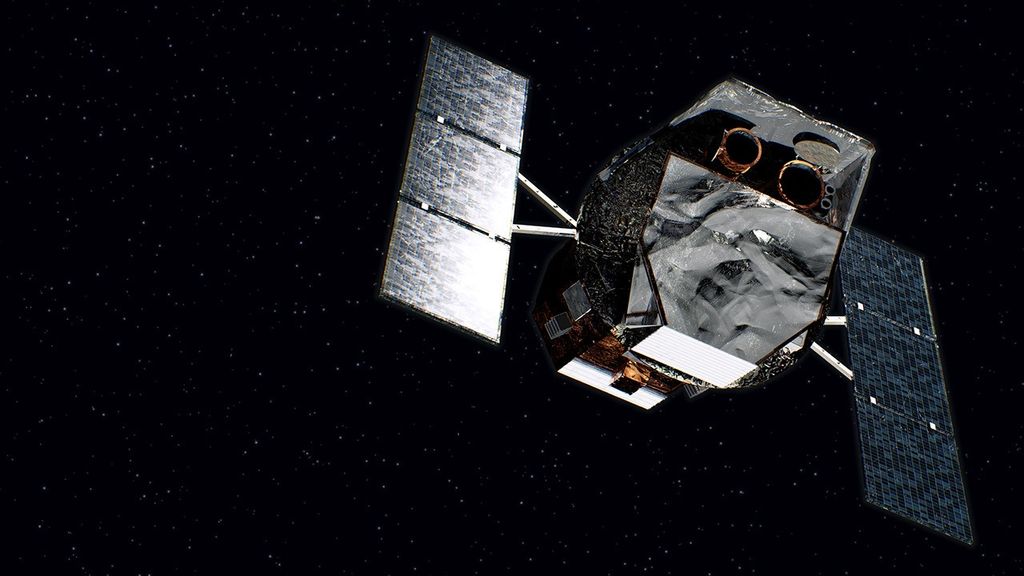
Steven Lee
Deputy Project Manager - NASA's Jet Propulsion Laboratory (JPL)
Contents
- Where are you from?
- Describe the first time you made a personal connection with outer space.
- How did you end up working in the space program?
- Who inspired you?
- What does your job entail?
- Tell us about a favorite moment so far in your career.
- What are you looking forward to in your career?
- What advice would you give someone who wants to take the same career path as you?
- What do you do for fun?
- Read More
- Where are they from?
Where are you from?
I grew up in Golden Valley, Minnesota, a suburb near Minneapolis.
Describe the first time you made a personal connection with outer space.
Apollo 11 landed on the Moon on July 20, 1969, my seventh birthday. If you want to inspire someone into the space program, land on the Moon for the first time on their seventh birthday! It was the Space Age, and I got thoroughly caught up in the worldwide excitement about exploring space.
Then, when I was nine years old, the Golden Valley library opened in my backyard. The books I discovered on their shelves opened my eyes to the wonder of airplanes, spacecraft, astronomy, and science fiction. I vividly recall the mind-blowing experience of realizing how big the universe really is. Through science fiction, I really enjoyed exploring possible futures and where humanity’s discoveries and inventions could lead. Each of the genres infused me with a sense of how logic and beauty could intersect to inspire wonder.
Find out what you’re passionate about and follow it. If you’re not sure, explore as many experiences as you can to find what inspires your passion and sense of wonder. – Steven Lee
How did you end up working in the space program?
I was so enthusiastic about space, I naturally thought, “How can I ever work in the space program when everyone will want to?!?!” So I carefully laid out a plan in high school and college. Knowing that Minneapolis-based Honeywell designed the flight control system for every crewed spacecraft from Mercury through the Space Shuttle, I decided to focus my studies on control systems at the University of Minnesota. The plan was to get a summer job at Honeywell then transfer to the space division in Clearwater, Florida, which is exactly how it worked out.
Of course, I later learned that it’s not nearly so competitive to work in the space program. There are many paths to a career in space exploration, most of which don’t need to be nearly so carefully defined.
Who inspired you?
Naturally, one of my biggest inspirations was Neil Armstrong, not only for his accomplishments but his Midwestern modesty and easygoing manner. I eventually managed to fulfill a childhood dream when I met him on the 35th anniversary and he wished me a happy birthday.
As I studied the space program in more detail, I was inspired by the brilliant and gutsy leadership of the early pioneers of the space program. For example, George Low was the low-key, unassuming Apollo spacecraft program manager. In April 1968, a Saturn V launched the unmanned Apollo 6 capsule. However, the rocket suffered excessive vibration so severe it would have injured any crew on board; two-second stage engines shut down and the third stage engine failed to re-light in orbit. After careful evaluation and fixes, Low decided that the next Saturn V launch would not only carry humans but take them all the way to the Moon for the first time – a gutsy but well-considered, rational decision. This mission, Apollo 8, sent the crew around the Moon and back in a highly successful and inspiring feat.
At JPL, an important mentor of mine was John Klein, a former Deputy Project Manager for the Mars Science Laboratory. John brought an amazingly optimistic, bright viewpoint to his work, mixed with tremendous intelligence and excellent judgment. He was also very focused on helping future generations fulfill their potential, which has inspired me to look for opportunities to help mentor whenever I can. Sadly, John passed away shortly before landing, but we commemorated him by naming the first-ever drill target on Mars after him.
What does your job entail?
As Curiosity’s Deputy Project Manager, I have the privilege of exploring Mars every day. No two days are ever the same since we’re constantly conducting different activities and facing new challenges. There might be a new technical issue to resolve, a staffing problem, or a budget revision to develop. It’s easy to let yourself get tied up in the intricate details of managing such a complex mission, but I make a point to take a few minutes each day to immerse myself in the latest images from Mars. When you study the contiguous sequence of terrain the rover traverses over days, weeks, and months, Mars starts to feel like a real place in a way that’s hard to get from a single out-of-context photo. My memories of Curiosity’s Martian traverses seem like memories of some of my favorite hikes on Earth.
I am also involved in advanced concept studies for potential missions to Enceladus, a moon of Saturn. Enceladus is an astonishing world shrouded in ice. In 2006, the Cassini spacecraft took an image of this moon back-lit by the sun. To the scientist’s amazement, they discovered plumes of water ice spewing from fissures in the south pole of Enceladus. Further observations confirmed the presence of a global ocean underneath an ice shell. Cassini flew through the plumes several times and sampled the material with onboard instruments. This analysis revealed the presence of salts, indicating the ocean is in contact with a rocky core, and organics, indicating the raw materials for life might be available. Could there be living organisms thriving through Enceladus’ ocean? Cassini isn’t equipped to answer that question, but it begs for a future mission to answer the ultimate question: Are we alone?
Tell us about a favorite moment so far in your career.
Successfully landing Curiosity on Mars after eight years of hard work with a brilliant team was an amazing experience. I had the privilege of serving as the Control Systems Manager for the Mars Science Laboratory. That role required deep involvement in many aspects of the design, development, and testing of the rover systems. Along the way, we faced many significant technical and programmatic challenges but also enjoyed some very satisfying accomplishments. It culminated in the tremendously gratifying landing night success and celebration. Like nerds winning the Super Bowl.
What are you looking forward to in your career?
I’m focused on astrobiology missions, the search for life elsewhere in the universe. The Curiosity Rover plays a key role by exploring the past astrobiology potential of Mars. While not equipped to detect signs of ancient life directly, the rover’s instruments allow us to explore whether Mars was ever hospitable for life with water, organics, and energy sources. Curiosity has confirmed that Gale crater was once not only habitable but habitable for millions of years.
Beyond Mars, several worlds in the solar system are compelling. I’m particularly intrigued by Enceladus, a moon of Saturn. An ocean of liquid water exists under the ice crust of Enceladus. Tidal flexing of the moon as it orbits Saturn has opened up fissures in the south polar region. Amazingly, plumes of water ice jet from these fissures into space. Some of the ice is actually spewed so fast it achieves escape velocity from Enceladus and enters orbit around Saturn forming the E-ring; another example of the convergence of science and beauty. It’s a phenomenal target for an astrobiology mission since the contents of the ocean are being served up for the taking by a spacecraft flying by.
What advice would you give someone who wants to take the same career path as you?
Find out what you’re passionate about and follow it. If you’re not sure, explore as many experiences as you can to find what inspires your passion and sense of wonder. Go to an aquarium. Spend an hour watching how ants actually go about their business. Visit some national parks. Volunteer at a museum or recreational facility.
Then try to get in touch with someone who already works in your career field of interest for advice. Find out what kinds of specialization and specific jobs are typically pursued, along with what type of education and experience is required so you can plan out your future.
What do you do for fun?
I enjoy reading books about paleontology and early life on Earth. I figure that if I’m interested in astrobiology, I should know a little about how life started and evolved on Earth. I also like snorkeling and diving, especially in search of exotic-looking creatures in coral reef ecosystems.
My wife and I also have a life goal of visiting every unit in the National Park system. We’ve already visited 332 but still have almost 100 to go, including some very remote ones in Alaska and the Pacific islands. Oh, and having grown up in Minnesota, I enjoy attending NHL hockey games and watching my son play high school hockey. (Yes, there are great ice hockey programs in Southern California!).
Read More
Mars Science Laboratory Homepage
Where are they from?
Planetary science is a global profession.





























